A prospective customer, or prospect, is a person or organization interested in making a purchase, with financial resources required, and the power to make purchasing decisions.
In the video below, Anya shares tips on how to convert prospects into loyal customers. Check it out!
What is the difference between a prospective customer and a lead?
There are no comprehensive criteria to distinguish leads and prospects. Both leads and prospects have an interest in your company’s products; they may be more or less qualified. However, differences between leads and prospective customers boil down to three points:
- Their place in the sales funnel. While leads are at the top, prospects have moved down to the middle.
- Interaction with business. Leads only receive information, while prospects negotiate with a company by email, phone calls, or attending meetings.
- Communication approach. Businesses interact with many leads at once, while with prospects they go for one-on-one communication.
How do you target a prospective customer?
- Get to know your customers
- Research your competitors’ audiences
- Set qualifying criteria
Targeting prospective clients is nothing to sneeze at. At least 50% of prospects turn out to be a bad fit for companies. Put differently, businesses waste tons of resources that won’t yield happy customers. To save time and money, start with researching which prospects can become your best clients. Here are three techniques that will help you.
Get to know your customers
Your clientele’s experience with your product is key to generate prospects. Start with composing a list of your key customers and find what they have in common. Maybe they work in the same industry, have similar financial indicators or needs. Look for these features in your prospective customers.
Another way is to ask your customer service and support teams about your clientele. Talking to clients every day, customer service specialists know who your customers are, how they use your product, and what makes them happy.
Finally, survey your best customers about your product. What do they like the most? What features are the most useful? What would they change about your product? These answers can shed some light on how you can effectively reach new prospects with the same needs.
Research your competitors’ audiences
People that love your competitors’ product could easily fall in love with yours too. Find out who they are — browse through competitors’ social media accounts, research their content, comments, and followers’ profiles.
Look at your competitors’ promotional content. What advantages does it highlight? Knowing what their customers like about the product gives you clues to things customers value that you can implement. Pay attention to social proof as well — it shows typical buyers, problems they face, and ways your competitors solve them.
Finally, pretend to be a potential customer too, test your competitors’ selling process, and learn from it. How do sales representatives communicate with prospects? What channels do they use? What questions do they ask and what features do they highlight?
Set qualifying criteria
Create a list of criteria to estimate if your prospects are effort-worthy. If you work in the B2B sector, hallmarks may be the company's budget, industry, the market they operate in, and more.
Include financial indicators, such as revenue or company growth. Businesses without financial problems probably have more interest in investing their money. Use company profiling resources — D&B Hoovers, TechCrunch, VentureDeal, or CrunchBase — to track their growth.
If you work in the B2C sector, create a buyer persona. Ask yourself about your ideal customer’s occupation, marital status, geography, income, pain points, and interests. The answers can be both speculative and empirical.
These techniques will help you save time and effort by picking the most promising prospects. After applying them to your sales strategy you can convert prospects into happy clients in short order.
How can you convert prospects into clients?
- Try uncommon communication channels
- Build customer-centric communication
- Show how your product works
- Use social proof and storytelling
- Automate your follow-ups
- Add prospects to your CRM
After targeting your prospects, it’s time to convert them into customers. We’ve picked five hacks to get the most out of your prospective customers and turn them into happy clients.
Try uncommon communication channels
What comes to mind when thinking of ways to reach your prospects? Our wager: calls and emails. However, only 23.9% of sales emails are opened, and it takes 18 calls to connect with a buyer. To stop losing time on calls and emails, implement new communication channels into your strategy.
For instance, while your prospect is still researching your product, offer them to interact with a chatbot. It can provide them with instant feedback around the clock, answer frequently asked questions, book consultations, and more.
Bots often gently push prospects towards the sales funnel, as Jamie Oliver’s chatbot does. It shows recipes as responses to emojis, offers Jamie Oliver’s new cookbook, and lets users share the bot on their Facebook page. It works well for both the book’s sales and promotion.
You can create an engaging chatbot for Facebook Messenger or Telegram for free in no time — register with SendPulse and squeeze every bit of value out of this marketing channel.
Build customer-centric communication
Hard selling is an excellent way to chase your prospects away. Instead of pushing your prospects to purchase, listen to their needs, and offer them help to accomplish their goals.
Another hack is to address your prospects’ pain points. Build your pitch around the problems your product helps eliminate. It’s a psychological trick that boils down to our brain’s predisposition to react more to potential losses than gains.
Cook Smarts use this tactic in their email communication. The email highlights a problem their prospects face every day — being swamped with meal planning — and offers a solution. You can use this approach not only in email marketing but also on other channels.
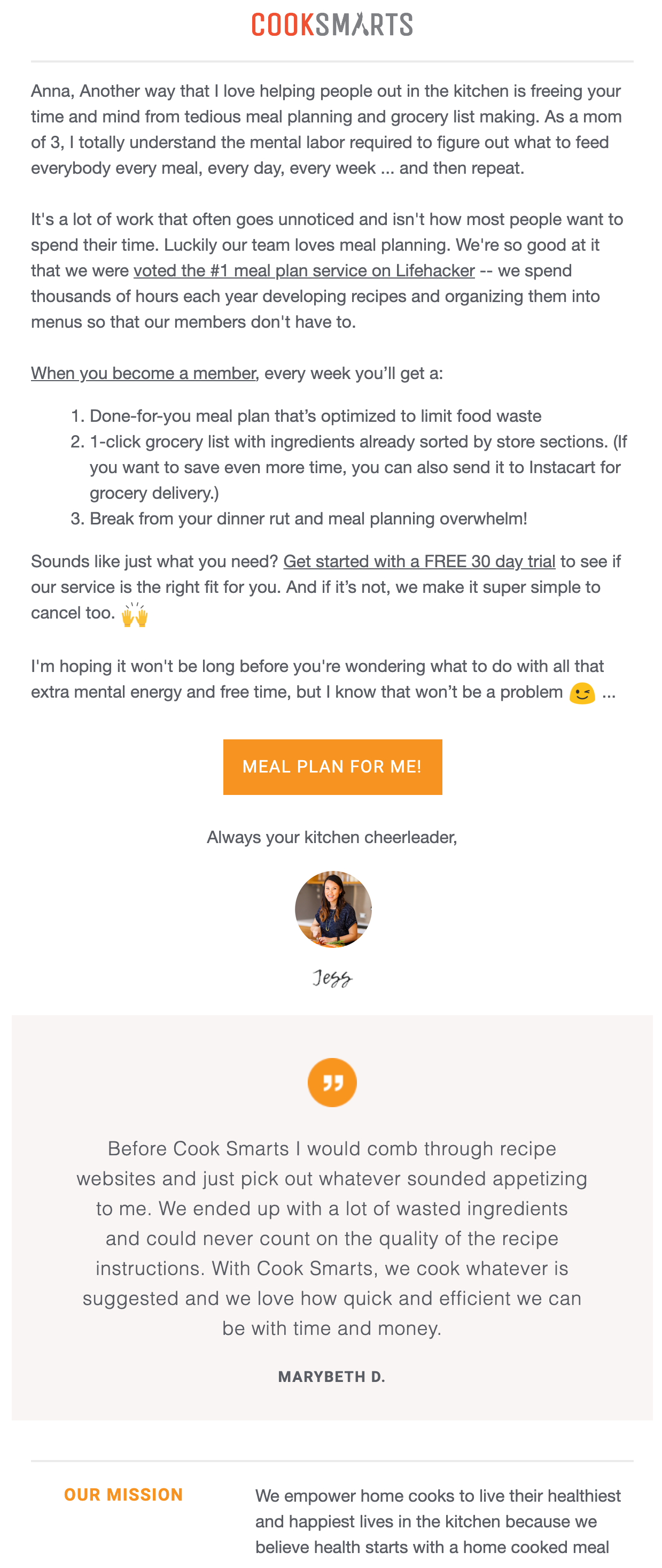
Show how your product works
More than half of the prospects are eager to know how the product works. Show them the whole set of features and opportunities your product provides. For instance, you can create a text or video guide, make a presentation, or a one-on-one consultation.
The best option is offering a free trial. It helps prospects to figure out if your proposal fits their needs, and gives you an additional reason to reach them after the trial expires.
Blue Bottle Coffee knows a thing or two about the power of a free trial — trying coffee once is more persuasive than describing it for hours. Moreover, the company uses this occasion for cross-selling in the “You Might Also Like” section.
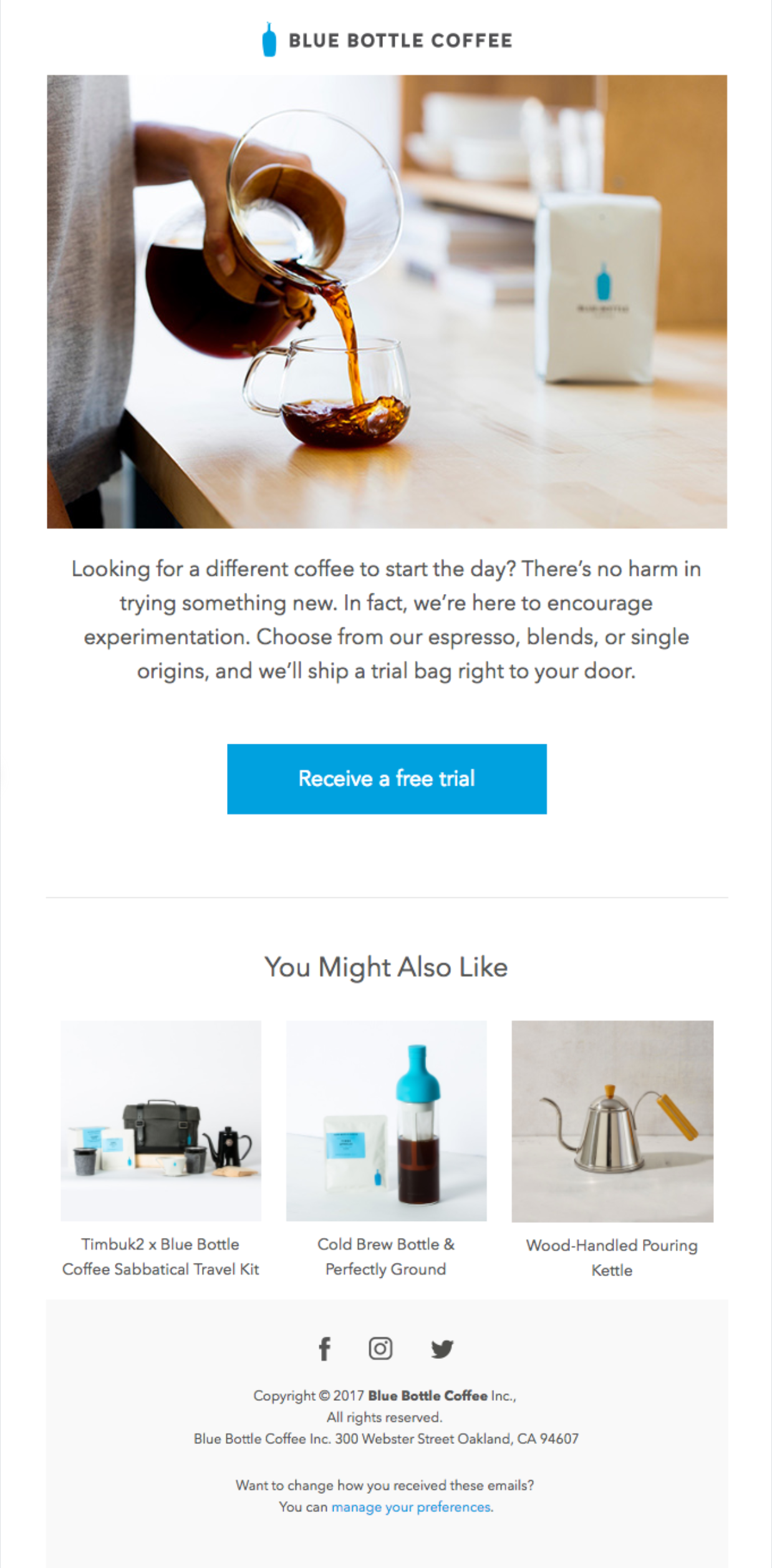
Use social proof and storytelling
95% of purchasing decisions occur in our subconscious mind, which makes emotional stories more powerful than facts. 88% of consumers trust user reviews as much as personal recommendations. Combined, storytelling and social proof can change your selling game.
Autopilot uses this technique in the email with an engaging story. To read the full text, the recipient goes to the website and sees a precise case study ending with a call to try Autopilot for free.
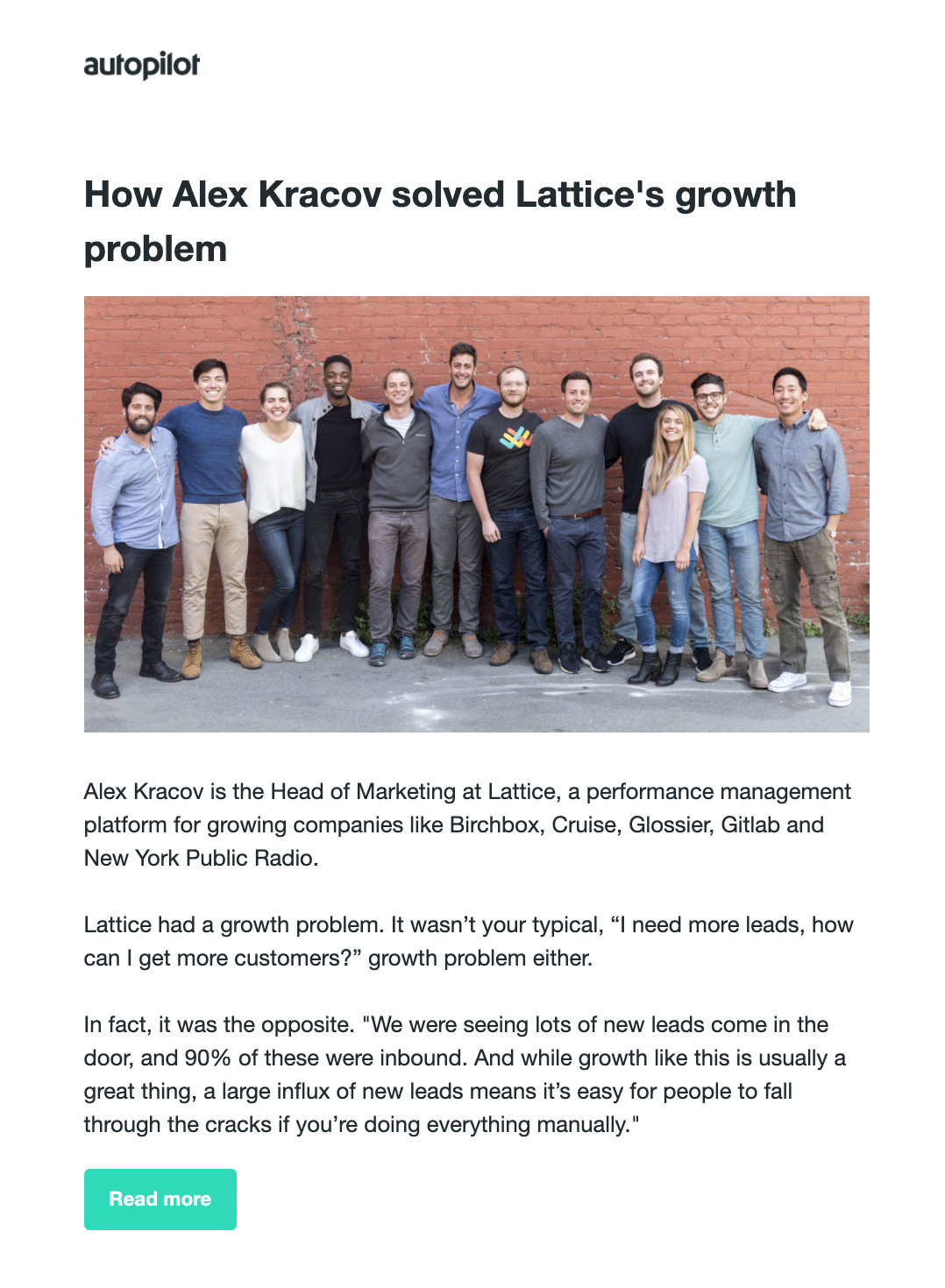
Automate your follow-ups
Top salespeople spend more time on sales-related activities, while others get stuck in operations. To save time, automate your follow-up messages, as we did in the example below with SendPulse.
This flow helps handle prospects’ contacts, manage connections within strict deadlines, and automatically finish the communication after reaching the goal. To automate your interactions with prospective customers, start with SendPulse’s Automation 360 tool.
We created a flow starting after a prospect opens the email reminding them that their trial expires in three days. After opening this email, they will receive an offer to buy a premium subscription. If the recipient purchases the premium subscription, the flow stops; if not – it continues with a promotional email.
Once opened, a prospect gets the next campaign with social proof. If they don’t react, the flow sends them an SMS. Those, who opened the social proof email, receive an additional trial. Meanwhile, the flow sends the seller a reminder to call those, who didn't react.
If a recipient didn’t click the CTA button in the latter email, the flow will change the contact's variable to “inactive.” In the other case, a prospect gets a thank you email.
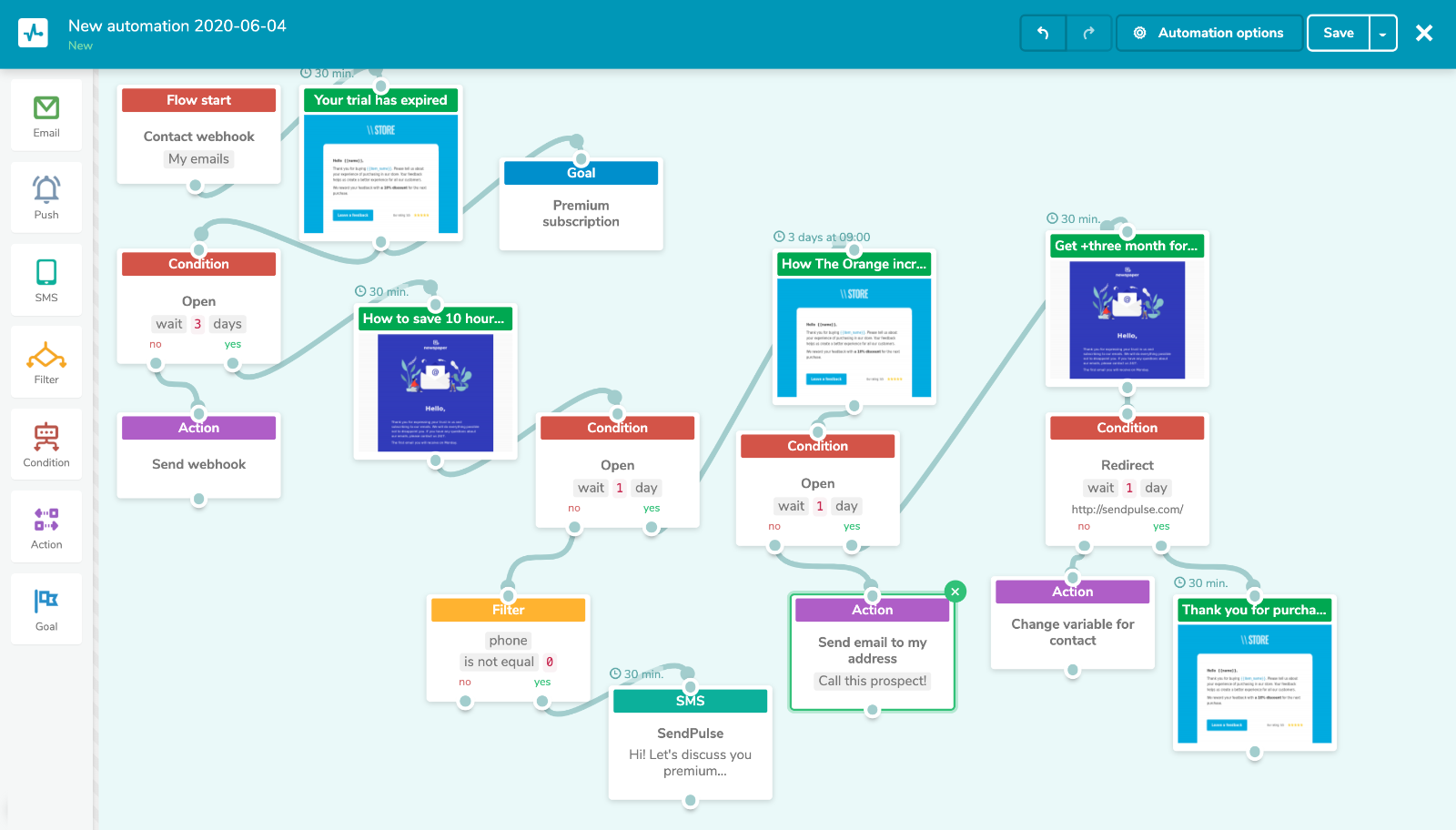
Add prospects to your CRM
With a CRM system, you can visualize your sales processes. It will help you record deals, monitor their progress, store information about clients to understand how well your strategy works. You can use the SendPulse CRM system for free. Accept orders, manage deals with the help of kanban-board, build your client list, communicate with customers via email or chatbot, and automate your pipeline in one place.
Look below to see how deals are displayed on a kanban-board. You can create new statuses, add information about clients and deals, and send them messages.
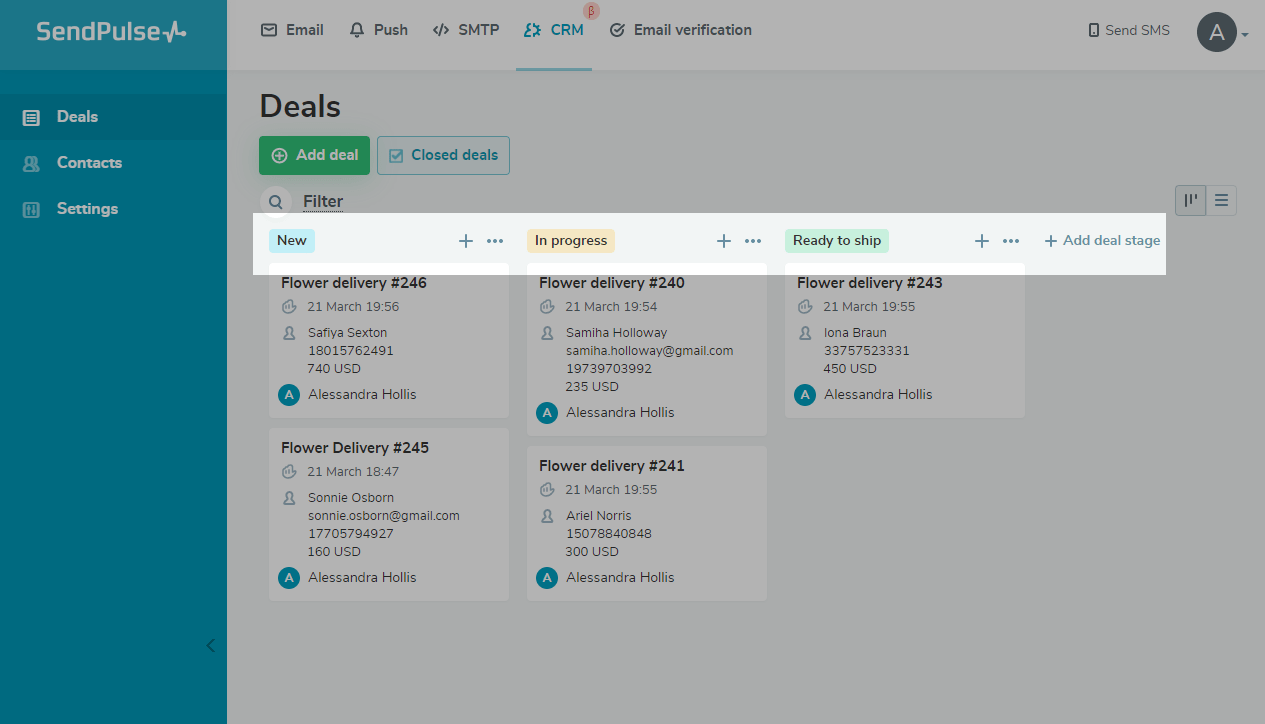
Working with prospective customers gets tough sometimes. However, you can ease the difficulty by targeting prospects properly, using the right communication strategies, automating everything you can, and applying various communication channels. Reinforce your prospecting with email campaigns, chatbots, web push notifications, and SMS — register with SendPulse to create them in a blink of an eye.
References
- The article "What is a Prospect Versus a Lead?" on The Balance Small Business considers the difference between a prospect and a lead.
- The article "10 Questions for Assessing a Prospective Customer" on Dummies provides answers to the most common questions regarding a prospective customer.
- The article "5 Ways To Get Prospective Customers to Choose You" on the Entrepreneur provides tips on how to make a prospect choose your business.
- The article "10 Steps To Target And Connect With Potential Customers Effectively" on Marketing Land provides insights into the art of targeting prospects.
Last Updated: 08.02.2024


or